Journal of Modern Physics
Vol.2 No.7(2011), Article ID:5783,5 pages DOI:10.4236/jmp.2011.27074
Where Is the Time Arrow Flying?
Provino, Moscow, Russia
E-mail: konushko@mail.ru
Received October 21, 2011; revised March 8, 2011; accepted April 11, 2011
Keywords: Irreversible Phenomena
ABSTRACT
Irreversible phenomena embrace all bodies of the physical world and the entire Universe on the whole, they introduce development to the Universe setting the motion and the pace to time. The latter is flowing just in one direction, from the past to the future, and no physical action can turn it back. Why is such an asymmetry? In this work the relation between entropy and granular spatial structure is established and the cause of the irreversibility of physical processes is thereby settled. The concept of time filled with a new physical meaning.
1. Three “Time Arrows”
The theoretical substantiation of the order and the direction of time raises a lot of debates. Why are instants of time are ordered like points on a straight line? Why is the time order asymmetric and time flows from the past through the present to the future?
With respect to teleology, Plato believed that time was an ordering element of the Universe introduced by the demiurge to convert chaos into space.
The most natural approach to the problem of theoretical substantiation of time irreversibility is an attempt of concluding this property from the entropy increase law (the idea was first suggested by Boltzmann).
The formula discovered by Boltzmann is very simple in form
 (1)
(1)
It relates entropy, a thermodynamic quantity, to state probability (W), a statistic quantity. The coefficient k was added to the formula by Plank and referred to as the Boltzmann’s constant. Indeed, all the macroscopic processes around us are, strictly speaking, irreversible, that is, they cannot go in the opposite direction. If we stir sugar in a cap of coffee, it is evenly distributed in the entire volume of the liquid. But it would be stupid to hope for the reverse process. The again of organisms is just one instant of the infinite set of irreversible processes we come across in everyday life. The direction in which these processes advance is characterized by a special physical quantity called entropy. If there is a closed system isolated from the rest of the world, where irreversible processes come about, the entropy of this system can only increase which points to its ordered, but more probable, state.
But the point of view, according to which the direction of our time is the one where the entropy increases in isolated systems, faced serous problems at once Loshmidt, Zermelo, Poincare formulated the so-called “reversibility paradox”. If there is an isolated system with a comparatively low magnitude of entropy, first the latter, as it must be, will rise and gain an equilibrium value. But later on, in rather a long period of time, it may drop again to its initial value. Moreover, the frequency of transitions of the system to low values of entropy will be, on the average, similar to that of high values. This seemingly sacrifices the definition “time direction” with the use of the entropy increase law.
The calculations show, however, that the time intervals in which, according to theory, the entropy of the system can decrease considerably, exceed by a lot of orders all the reasonable estimations of the time of existence of our Universe, about 1010 years [1]. Experiments show that in any closed macro-system the entropy increases to a certain maximum magnitude and then remains almost constant. Thus, in spite of “reversibility paradox”, it is the direction in which most irreversible processes occur in isolated systems, that fixes the direction of our time.
We should agree, however, that the conclusion about the relation between the time direction and the entropy increase law, despite its importance, cannot be considered as an absolutely true theoretical substation of irreversibility. In order to substantiate theoretically time irreversibility, it should be deduced from a fundamental law of nature. But most known laws are invariant with respect to changes in time direction (T denotes the invariance). An increase of entropy in closed systems is not a law of nature but rather an extremely common empirical regularity which needs its theoretical but empirical regularity which needs its theoretical study; so it is not theoretical but empirical verification of time. Using Eddington’s imagery expression we can refer to the relation between the entropy increase law and time irreversibility as “thermodynamic time arrow”.
The “electromagnetic time arrow” is related to the irreversibility of electromagnetic radiation. As experiments show, a point charge radiates spherical waves propagating to infinity but there is not a reverse process, that is, the propagation of spherical waves from infinity and their absorption by a point charge. Wheeler’s and Feynman’s theory cannot substantiate time irreversibility either since it does not forbid the existence of purely leading effects and the opposite time direction.
The “cosmological time arrow” is most often associated with the expansion of the Universe. According to this standpoint, it is the expansion of the Universe that specifies the sing of time direction.
At present a lot of hundreds of papers deal with the problem of “time arrow” formation and the essence of time itself. The below two articles contain a great number of references [2].
M. Bojowald takes seriously quantum space-time as a fully dynamical quantum entity. More specifically, cosmological makes models lead us to an analysis of quantum correlations as quantities changing with a trend. If consistently realized, such a perspective is very different from the traditional ones regarding time: time would be inherently quantum; it would not exist in a classical word. In semi-classical physics, it remains only as a shadow of the quantum physics that lies beneath.
C. Keefer addresses the question whether the origin of the observed arrow of time can be derived from quantum cosmology. He gives a brief introduction into quantum geometry-dynamics and argues that this may provide a sufficient framework for studying this question. Then he shows that a natural boundary condition of low initial entropy can be imposed on the universal wave function/ the arrow of time is then correlated with the size of the Universe and emerges an increasing amount of decoherence due to entanglement with unobserved degrees of freedom.
The research into irreversible processes carried out by I. Prigogine et al. begins with the acknowledgement of the indisputable fundamental fact—the entropy increase law and the ensuing existence of “the time arrow” [3].
For this statement not to remain purely declarative, it is necessary for us to find a fundamental law of nature from which it follows that entropy increases in closed systems. The rest of this article is concerned with a search for this law.
2. Entropy and Black Holes
After Planck introduced the fundamental constant t1 in 1900 he pointed out to a possibility of constructing a new system of units not related to any artificial standards. These are the following units:
Length 
Mass 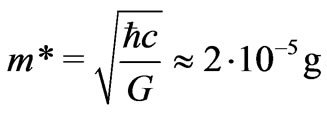
Time 
The units introduced by Planck have a specific feature. Their existence means that in nature, in the Universe, there are only these scales related to the quantum and relativistic properties of the world at the same time. It is just these units that are to become the key which will enable us to reveal the secrets of the spatial structure, entropy and “time arrow”.
In 1971 Hawking proved the area theorem which says that the area of event horizon of a black hole cannot decrease: no matter what would happen to a black hole “its surface area” must either increase or remain constant [4]. If matter or radiation fall into a black hole, the surface area of its event horizon increases and when two black holes merge into one hole the surface area of the resultant event horizon will be equal to or larger than the total surface area of the event horizons of the two original holes taking part in the collision.
In 1972 Beckenstein studied the similarity between the behaviour of entropy and the properties of event horizon. In both the cases one can see a common peculiarity: they never decrease in any physical process [5]. It was advisable to consider the black hole entropy proportional to the surface area of the event horizon: S~A. But how can we make both ends meet if the area A has the dimensions of squared length? It was suggested that the black hole entropy should have the form
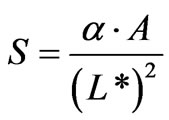 (3)
(3)
The coefficient ά was calculated later by Hawking. It proved to be 1/4. And, if Planck introduced the concept of elementary length L*, Beckenstein and Hawking went farther and proposed the concept of elementary area (L*)².
In 1975 the author of this paper made the next third logical step and introduced into theory a three-dimensionnal object, namely, an elementary cell with its volume (L*) ³. Then he put forward the hypothesis that the whole Universe is only made of one element, an elementary cell (a grain) and developed the theory of granular space [6].
The quantity (L*)² acquires a clear physical meaning—it equals the elementary cell area. Then the mysterious quantity entropy, the black hole entropy in our case, is equal to the number of elementary cells N forming the surface area of the event horizon of a black hole
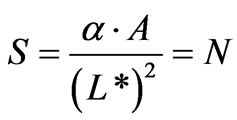 (4)
(4)
But a black hole is an exotic object, and our task is to clarify the question how entropy is related to the structure of a space with ordinary bodies in it. The answer is provided by the theory of cellular space [6-8].
3. The Structure of Interacting Fields
Three world constants—ћ, c and G characterize the elastic properties and the dimensions of a spatial cell which can be deformed up to a break-down. The deformation of elementary cells results in collectivization when a huge number of cells unite to form a bigger macrocell. The effect of cell collectivization provides the basis for the riddle of “large numbers”—the Coulomb force of two electrons is 1042 times larger than their gravitation interaction. All elementary particles have the same fundamental property: if they are brought closer to each other, only the matter of one cell will take part in their gravitational interaction! That is why the gravitational forces of small objects are so weak.
The mass of an elementary particle is the amount of matter which is necessary to form the latter.
The “body” of a particle is formed by elementary particles of the space itself, and the mass is spent to form a stable surface of the particle, in case of resonances just for a short instant. The word “confinement” can be fully applied to the internal cell of space captured by the mass of particle. The birth of a particle leads to a deformation of both external and internal cells of space. The radial and axial deformation of external cells, with respect to the particle, forms a layer structure being the essence of all kinds of physical fields: gravitational, electric, magnetic, gravimagnetic and the particle spin. This structure is complicated many times by the interference of radial and axial deformations.
In our imaginary experiment once often used by prominent physicists let us increase an electron to the dimensions of a foot ball and cut it by a plane passing through the middle of the particle. In this case we can see a layer structure roughly reminding us of the structure of an onion with one embryo. The same structure can be found in all leptons. As the mass of a particle increases, its inner structure becomes more complex. Energetically it is advantageous for space to form clusters of deformed cells formed to by us as quarks; quark confinement becomes evident because these clusters of deformed spatial cells inside a particle are made due to a large mass of mesons and nucleons reminiscent now of onions with two or three embryos. The structure of the layers of a spatial cell which are external with respect to the particle surface is more important for solving the problem of entropy.
The discrete structure of space, the deformation of cells and the fact that each layer is a two-dimensional surface give rise to macrocells which become larger as the observer moves away from the particle surface. We have already called this process by two measurements of the surface of each layer?
The deformation of one cell is able to extend just to 4 cells in a more removed layer; a macrocell consisting of four cells will turn to a macrocell of nine cells, etc.
Let us denote the distance between the center of symmetry of an elementary particle and the place where each cell is deformed individually by r0. This distance is equal to the size of the particle only in gravitational interaction. A question of great importance is at what distance a four-cell macrocell can be formed. This distance r2 = 4r0 since only a two-dimensional surface with its radius 4r0 can be covered closely, without blanks, by a whole number of macrocell made up of nine cells will for the same reason cover a layer spaced at r3 = 9r0 from the center of the particle.
The general formula looks thus
 . (5)
. (5)
This imaginary experiment allowed us to observe the formation of gravitational energy levels—an effect predicted by the cellular space theory [6-9].
In 1913 N. Bohr introduced the concept of stationary orbits, that is, energy levels in Coulomb interaction where the positive and the negative changes of a position and an electron form a huge macrocell with N ~ 4.17 × 1042
in the space between them at the distance 
The significant difference between gravitational and Coulomb interactions lies in the fact that in the former it is just an active gravitational mass that forms energy levels which is supported by the equal acceleration of all the bodies falling on this mass. In the latter both the charges are equally responsible for the formation of energy levels.
When moving away from the particle under consideration one can see the chaotic arrangement of deformed cells give way from time to time to ordered layers consisting of macrocells and reminiscent of the surface of a foot ball.
It is rather interesting that in both cases, be it the transition of an electron from one energy level to another one in an atom or the falling of particle on a gravitational center, the Earth for instance, these transitions are followed by a throw-off of photos. All this enables us to state that both synergetics and disaster theory originate from one elementary spatial cell.
The gravitational potential φ of the particle m at the distance r from this particle is:
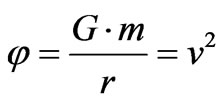
or
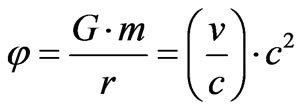 (6)
(6)
But the value of c²/v² is numerically equal to the number of elementary cells. These macrocells cover the layer under consideration. In this case v²/c² serves as a measure of relative deformation, and we have extremely valuable information. The velocity v can be considered as an iceberg the relative movement of the body, whereas the underwater part (it determines the physical meaning of velocity) is related to the relative deformation of spatial cells in the given frame of reference. This fact will enable us to obtain easily Schwarzchild metric and to understand the physical meaning of Einstein gravity theory.
4. Entropy Increase and Irreversibility of Physical Processes
A black hole is an object whose surface cells possess maximum deformation. Mathematically this fact is proved by the equality of the gravitational potential on the surface of a black hole to the velocity of light squared c²
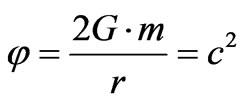 (7)
(7)
A peculiarity of the surface layer of cells in a black hole is that these cells are aligned along a spherical surface to form a huge macrocell. The envelope of the wave front of a flying photon is a sphere, too Bodies of a smaller mass possess a lumpy-smooth surface, and, the sizes of the bodies being equal, the larger is the mass of the body, the larger is the surface macrocell.
All the above-said allows us, finally, to understand both an increase in entropy and the cause of irreversibility of physical processes in closed systems. Take a big vessel with its volume V, a part of which ∆V is separated by a partition. Let this small volume ∆V be filled with gas molecules and the rest of V be empty. The spatial cells round the volume ∆V are highly deformed by the gas in it, and the rest of the volume is surrounded by less deformed cells. The partition sets up artificially a deformation gradient of spatial cells.
After the partition is removed, the gas molecules gradually fill the volume V, which causes the deformation gradient to disappear and all the cells inside the vessel will be deformed uniformly. Slight fluctuations of cell deformation in different places of the vessel are not excluded but the situation, when all the molecules cluster in a small part ∆V and which would lead to a spontaneous increase of cell deformation in one place of the vessel and to its disappearance in another part, can never occur spontaneously.
It is a natural quest of elementary cells to distribute deformation equally among themselves, that is the law which the “time arrow” follows.
The entropy itself is equal to the number of deformed elementary cells forming a macrocell owing to the effect of collectivization. Such macrocells closely cover the surface of the physical system under consideration. With the same mass of the gas involved, the surface of the part of the vessel ∆V is much smaller than that of the whole vessel V. Hence, the macrocell covering the surface of the entire vessel is much larger the one which covers the surface of ∆V. As a result, the entropy of the final state is far beyond that of the initial state.
The irreversibility of physical processes in a closed system is not caused by an increase of entropy, on the contrary, it is followed by the latter. The cellular space theory interchanges cause and effect in this extremely important subject.
The relation found between entropy and spatial structure is also of great importance for studying biological systems and, in general, for all non-equilibrium processes.
The number of research papers concerned with the essence of time is huge but the granular space theory has its own look at this mysterious substance.
5. Mystery of Time
Since the size of an elementary cell is too small we have to turn again to an imaginary experiment with the size of a cell increased so that it might be visible to the naked eye. Imagine some space without any elementary particle. You would see orderly rows of elementary cells pressed closely to each other. One can see here both lines (one-dimensional space), planes (two-dimensional) and volume (three-dimensional space). The problem of threedimensional space has a long story. An elementary cell enables us to understand why space is three-dimensional because when we place cells of any shape in three orthogonal directions, we fill up free space tightly, without gaps, thus building up Space proper. In this lifeless desert there is no place fore the concept of time.
Let us change the situation and place an elementary particle into the area under observation. The space cells will have to make room for the new object, and one can see a deformation wave rolling from one layer of cells to another thus visualizing the basic mathematical operations.
Indeed, an elementary cell in itself gives grounds to introduce the concept of natural numbers. The presence of a center of perturbation (of a particle) passes into divergence, the difference in radial deformation of two adjacent layers leads to a gradient, axial (torsion) deformation in a layer of cells is associated with the concept of rotor. These three abstract mathematical operations are quantitative characteristics of all types of physical fields and particle spin.
We have to admit that Galileo was right saying that nature speaks a mathematical language to us but the real granular space makes all these mathematical operations visible to the naked eye, which supports Feynman’s prevision that in the long run physics will not demand mathematical statements. Its mechanism will be clear to us and the laws will become as simple as a chess-board even though it seems rather complicated.
Let a deformation wave run far beyond visual range. In this case we cannot observe any changes in the space volume under investigation and thus time ceases to exist. So we can draw the surprising conclusion that it is a successive change in deformation of one elementary cell that gives grounds to introduce the fourth coordinate of space-time.
Thus, we can observe the movement of a deformation wave in two different ways:
1) To pass from one cell to another together with the wave moving in this case in three dimensions -X-, -Yand Z-coordinates;
2) To follow the deformation of only one chosen cell in the same place (without moving). And then we shall have to introduce the fourth coordinate, i.e. time.
Time has proved to be closely associated with space. The space cells around a moving body are overfilled with a material referred to as kinetic energy; the cells lose their elasticity, which causes the physical processes to slow down.
Any body pushing part of the space cells outside increases the filling of the ambient cells with the material, too, which again slows down the time tempo near the center of gravity.
6. Conclusions
Granular space theory gives a comprehensive idea of what time means, how and on what time tempo depends and why physical processes in closed systems are irreversible in time.
REFERENCES
- C. Marchal, “22 International Workshop on High Energy Physics and Field Theory,” Protvino, 1999, pp.108-120.
- M. Bojowald, “A Momentous Arrow of Time,” arXiv: 0910.3200 l [gr-qc], 2009.
- I. Prigogine, “From Being to Becoming,” W. H. Freeman and Company, New York, 1980.
- S. Hawking, “Black Holes in General Relativity,” Communications in Mathematical Physics, Vol. 25, 1972, pp. 152-166. doi:10.1007/BF01877517
- J. Beckenstein, “Holes and Entropy,” Phisical Review, Vol. D7, 1973, p. 2333.
- V. Konushko, “Concepts of Granular Space Theory,” Sputnik, Moscow, 1999.
- V. Konushko, “Granular Space and the Problem of Large Numbers,” Pushchino, Moscow, 2001.
- V. Konushko, “Gravitational Energy Levels and the Problem of the Universe Cosmic Background Radiation,” Pushchino, Moscow, 2001.
- C. Kiefer, “Can the Arrow of Time be Understood from Quantum Cosmology?” arXiv: 0910.583 l [gr-qc], 2009.

